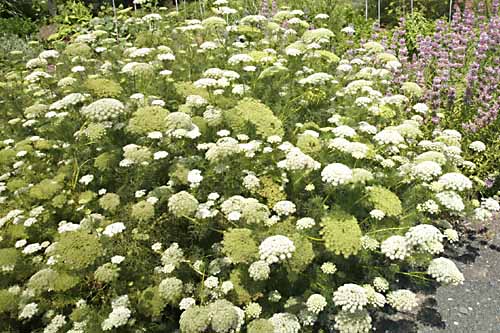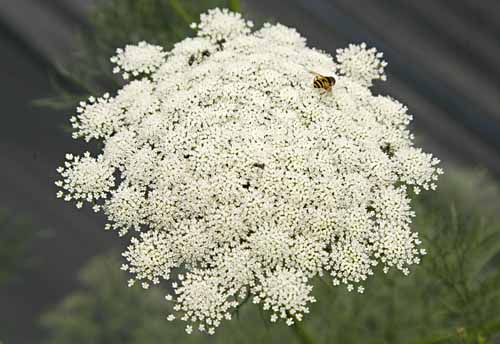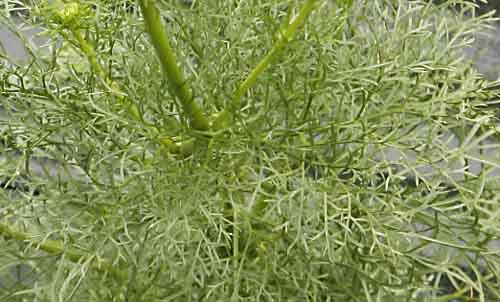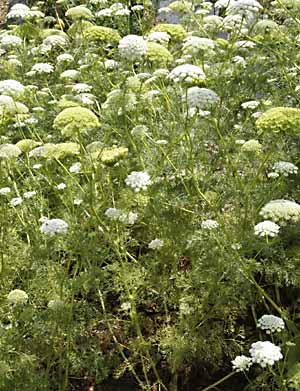A truly lovely plant with masses of fine feathery fern like foliage and large
white flower heads that seem to float on the sea of green foam. Visnaga makes
a wonderful addition to any border or as a plant in its own right. The huge
white flower heads are noticeable at a considerable distance and the foliage
makes a wonderful contrast to almost any plant. Easy to grow it takes little
maintenance once established this annual plant will self seed happily if left
alone. It needs full sun and water to show its best, but the blooms which make
excellent cut flowers or can be dried for later use are worth the small effect.
Caution. The sap from this plant can cause
skin irritation and even blisters in some people. Take care if picking, use
caution around young children and pets.
Description
Growing to the height of about 4 feet (120cm) tall and 4 feet (120 cm) wide
Ammi is a mass of finely cut filigree link foliage. Each leaf is about 8 inches
(20cm) long very finely cut and divided. They are mid green in color with a
hint of gray. Leaves are arranged in opposite clumps on the thick slightly arching
branches. Each leaf terminus can give rise to a flower stem making the plant
very branched. The flower heads are located at the tops of the stems as large
umbels that can branch to as many as a hundred individual rays. Each of these
contains a tiny white to greenish-white flowers in their own small grouping.
Flower heads can be as large as 6 inches (15cm) across and slightly dome shaped
they appear from June until September. Each umbel is very stiff and as the seeds
ripen the heads contract around themselves forming "nests" as this
happens the heads become harder and more woody. These "nests" are
hygrochasic meaning the open up in damp weather and close during dry conditions.
Each flower produces small smooth seeds about 2mm long. One seed head can offer
up a multitude of seeds.
Since plants can become large and much branched with each branch ending in a flower head the whole plant become covered in large white flower heads seemingly floating on a sea of fine green misty foliage. Ammi makes an excellent cut flower as the stalks are stiff and the flowers long lasting.
Location and Care.
Visnaga needs full sun or very partial shade and a well drained but moist soil.
It is not fussy about the soil type as long as it is not wet. It needs moisture
and does not tolerate drought well. Full size will only be obtained if the conditions
are right with enough water and organic material in the soil. With less organic
material and water the plants will still grow and may reach 3 feet tall but
will not spread out as much. Additional feeding during the year is suggested
for maximum sized plants. Run a soaker hose near the base of the plants and
use for daily waterings if no rain for maximum plant sizes.
Growing.
Seeds should be pre-chilled for at least two weeks at temperatures below 40°F
(4°C) before sowing. All our seed has been pre-chilled.
Sowing indoors. Start seed about 6 weeks or sooner before the last frost date.
Cover seeds lightly and germinate at in the range of 68-72° F (20-22°
C). At these temperatures germination should occur within 10-14 days. Transplant
seedlings to their own pots when they are large enough to handle and grow in
to about 4-6 inches before planting out. Harden off plants in partial shade
before planting in full sunshine location.
Direct sowing. Sow after all danger or frost has passed. Germination in situ
can take from 1-4 weeks depending on soil conditions and temperature. Water
and keep moist until seedlings have germinated and began to grow well. Thin
plant to about 2-3 feet apart.
In some areas the plants can be sown
in fall and over wintered in cold frames
or in the garden if it is not cold. This will produce larger plants that flower
earlier than spring sown plants.
Harvesting
Cut flowers. Harvest in the early morning after the dew has dried. Ammi
makes a wonderful cut flower and the foliage is an excellent foil for many different
displays.
Dried flower. Harvest as for cut flowers. Hang flower heads in small
bunches upside down in a dark warm place. Dark is essential to help preserve
the white color of the flowers. Light when drying causes them to turn brown.
Seeds/fruits. The fruits are harvested just before they are ripe, normally
in late summer. Cut the heads off individually and place in a bucket or bin.
Dry the seed heads in the sun or dehydrator and thrash to remove the seeds/fruits.
Fruits are then made into a tincture for later use.
Caution.
The sap of the Ammi plants can cause a rash or skin irritation in some people
that can become very painful. The sap contains compounds that become active
when exposed to light and can cause blistering of the skin. Always wear long
sleeves and gloves when handling these plants. Use snips to cut the flowers.
If exposed to the sap wash immediate with soap and water. If symptoms occur
after contact call your local Poison Control Center.
Medicinal uses.
An extract from the seeds/fruit is considered to be a powerful muscle relaxant
making Visnaga particularly useful in treating many conditions. The extracts
contain khellin which is used in several pharmaceutical drugs to treat asthma
especially in children. In many cases visnaga can help avert the recurrence
of asthma bouts even if it is not entirely effective in healing a very severe
bout of the condition. The Arab world has used Visnaga for centuries as a bronchodilator
- a substance that expands the bronchi or the breathing tubes - giving relief
to asthma symptoms as well as those of acute allergy symptoms, bronchitis, emphysema,
and whooping cough.
The same muscle relaxant properties are also effective on the kidneys relaxing
the ureter, the tube that connects the kidney to the bladder. This is especially
effective in helping to release kidney stones which can become logged in the
tube causing acute pain, with relaxed muscles the stones can passed down to
the bladder and be expelled. .
Visnaga can also help relax arteries and heart muscles thus soothing symptoms
of angina and possibly lower the blood pressure. In all cases the effects of
the herb last about six hours with no reported side effects.
Other uses.
The tough flower head when dried becomes woody. These sections are used in many
Mediterranean countries as very effective toothpicks.









